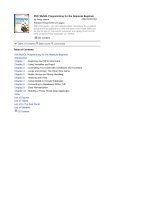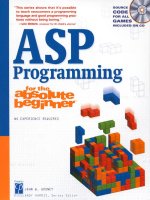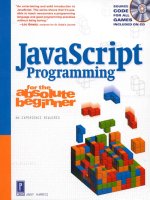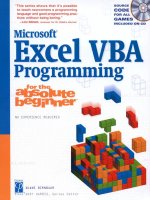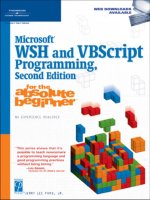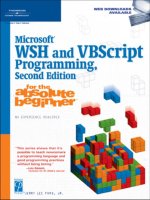Tài liệu ASP Programming for the absolute beginner pptx
Bạn đang xem bản rút gọn của tài liệu. Xem và tải ngay bản đầy đủ của tài liệu tại đây (7.31 MB, 337 trang )
TEAMFLY
Team-Fly
®
ASP
Programming
JOHN GOSNEY
®
Untitled-10 2/25/03, 10:32 AM1
© 2002 by Premier Press, Inc. All rights reserved.
No part of this book may be reproduced or trans-
mitted in any form or by any means, electronic or
mechanical, including photocopying, recording, or
by any information storage or retrieval system with-
out written permission from Premier Press, except
for the inclusion of brief quotations in a review.
Premier Press and For the Absolute Begin-
ner are registered trademarks of Premier
Press, Inc.
Microsoft, Windows 95, Windows 98, Windows
2000, Windows NT, Internet Explorer, FrontPage,
and VBScript are trademarks or registered trade-
marks of Microsoft Corporation.
Important:
Premier Press cannot provide software
support. Please contact the appropriate software
manufacturer’s technical support line or Web site
for assistance.
Premier Press and the author have attempted
throughout this book to distinguish proprietary
trademarks from descriptive terms by following the
capitalization style used by the manufacturer.
Information contained in this book has been ob-
tained by Premier Press from sources believed to
be reliable. However, because of the possibility of
human or mechanical error by our sources, Premier
Press, or others, the Publisher does not guarantee
the accuracy, adequacy, or completeness of any in-
formation and is not responsible for any errors or
omissions or the results obtained from use of such
information. Readers should be particularly aware
of the fact that the Internet is an ever-changing
entity. Some facts may have changed since this book
went to press.
ISBN: 1-931841-01-2
Library of Congress Catalog Card Number:
2001091383
Printed in the United States of America
01 02 03 04 05 RI 10 9 8 7 6 5 4 3 2 1
Publisher:
Stacy L. Hiquet
Marketing Manager:
Heather Buzzingham
Managing Editor:
Sandy Doell
Acquisitions Editor:
Melody Layne
Project Editor:
Heather Talbot
Technical Reviewer:
Chad Beckner
Copy Editor:
Kate Talbot
Interior Layout:
Danielle Foster
Cover Design:
Mike Tanamachi
Indexer:
Katherine Stimson
Proofreader:
Jenny Davidson
Untitled-10 2/25/03, 10:32 AM2
To my father, Richard Gosney, for inspiring my dreams.
To my mother, Marilyn Gosney, for helping me so much
in achieving them. I love you both very much.
Untitled-10 2/25/03, 10:32 AM3
This page intentionally left blank
A
c
k
n
o
wl
e
d
g
m
e
nt
s
I
have written several books, and I am always struck by the same thought as
the writing process for each one comes to an end: that is, over the course of
a few short months, life can take a fantastic array of twists and turns. Working
on a project like this one provides neat bookends to a beginning and an end,
and always—without fail—forces me to pause and review the previous months of my life.
Sometimes, these periods are filled with joy, as occurred with my last project and my son
being born as the book neared completion. Yet other times, life takes unexpected and
traumatic turns. As I write this, my mind continues to dwell on the tragedy of September
11, 2001, and the thousands of people who have lost their lives. It has been difficult to
accept the events of that day. Moreover, it has marked the ending of this particular project
as indeed one of the darker bookends in my, and the world’s, lifetime.
But as with all things, healing does begin, and the pain (if not the memory) of such a
tragedy is gradually lessened. As befits a computer book, the real promise of technol-
ogy (that is, of making the world a better place) reminds me, as I write this, that there
is still great promise in the world, and that human ingenuity, creativity, perseverance,
and kindness can (and will) prevail. Technology and all the benefits it brings can help
deliver this promise, and it is this thought (among many) that has gotten me through
these sad and mournful days.
That said, there are many people who have worked on this book who, through their
efforts, have kept this promise of technology alive and well, and have in turn helped to
make this book far better than it ever could have possibly been. Once again, Emi Smith
has come through with her fantastic organizational details, always willing to lend a
sympathetic and understanding ear to the trials and tribulations of her authors. Thanks
as well to Heather Talbot who picked up this book after many internal changes, keep-
ing it on track and thus guiding it to the light of day. Also, thanks to Chad Beckner for
ensuring the technical accuracy of the book, and for continuing to answer—always
with good humor—my silly technology questions. And to all the other folks at Premier
Press who, while perhaps going specifically unmentioned, have my enduring grati-
tude for making sure a project is done right, and done well.
Finally, and as always, all my love and thanks to Melissa, Genna, Jackson, and George
who make everything possible and inspire me to always do my best.
Untitled-10 2/25/03, 10:32 AM5
This page intentionally left blank
A
b
o
u
t t
he
A
u
t
h
o
r
J
ohn W. Gosney is currently Director of Technology Services for the Indiana
University School of Dentistry, Indianapolis. He has also served as a technical
writer and Web development consultant for a major pharmaceutical corporation.
John has worked extensively with Microsoft applications and Web develop-
ment tools for several years, and has experience with ColdFusion and other Web devel-
opment technologies. He is the author of several books, ranging from test preparation
guides to e-business titles. John is also an adjunct instructor for the Community Col-
lege of Indiana.
John received his B.A. in Technical Writing and Psychobiology in 1992 from Purdue
University. In 1996, he was awarded an M.A. in English from Butler University. When
not working (which is rare these days!), John enjoys spending as much time as he can
with his family, cheering for his favorite teams (Pacers, Colts, and Boilermakers) and
furthering his reputation as an expert in all things popular culture.
Untitled-10 2/25/03, 10:32 AM7
Untitled-10 2/25/03, 10:32 AM8Untitled-10 2/25/03, 10:32 AM4
This page intentionally left blank
C
on
t
e
n
t
s a
t
a
G
la
n
c
e
Introduction xix
CHAPTER 1 Preparing to Work with ASP 1
CHAPTER 2 Programming ASP Web Pages with VBScript 23
CHAPTER 3 Working with ASP Objects 43
CHAPTER 4 Working with ASP Components 71
CHAPTER 5 Database Access with ADO 83
CHAPTER 6 Using Forms 109
CHAPTER 7 Essential Programming Logic, Part I 143
CHAPTER 8 Essential Programming Logic, Part II 161
CHAPTER 9 Formatting Processed Output 189
CHAPTER 10 ASP and HTML Scripting with FrontPage 2000 215
CHAPTER 11 Looking Back and Looking Forward 261
APPENDIX A VBScript Variable Reference 267
APPENDIX B SQL Reference 277
APPENDIX C Access Essentials 285
Index 301
Untitled-10 2/25/03, 10:32 AM9
This page intentionally left blank
TEAMFLY
Team-Fly
®
Introduction xix
Preparing to Work with ASP 1
Understanding ASP and the Web Server 2
The Advantages of Server-Side Processing 2
VBScript, the Heart of ASP 3
Configuring Your Web Server for ASP 4
Configuring Internet Information Server
with Windows 2000 4
Installing Internet Information Server 5
Confirming Your IIS Installation 7
Configuring Personal Web Server with Windows 98 10
Installing Personal Web Server 10
Confirming Your PWS Installation 12
Confirming Your Web Server’s ASP Functionality 13
Displaying Your Web Server’s Default Home Page 15
Displaying the Default IIS Home Page 17
Displaying the Default PWS Home Page 18
Choosing an ASP Application Development Tool 18
Summary 20
Programming ASP Web Pages
with VBScript 23
Integrating VBScript with ASP 24
Client-Side versus Server-Side Processing 27
Understanding VBScript Variables 29
Declaring Constants in VBScript 31
C
on
t
e
n
t
s
1
CHAPTER
2
CHAPTER
Untitled-10 2/25/03, 10:32 AM11
xii
C
on
t
e
n
t
s
Learning to Program with VBScript 32
The IF THEN Statement 33
The FOR NEXT Statement 37
Commenting Your VBScript Code 39
The Hello, World! Game 40
Summary 41
Working with ASP Objects 43
Introducing the Request and Response Objects 44
The Request Object 45
Understanding Object Collections 47
Introducing the File Object 52
The File Object Properties 53
The File Object Methods 54
A File Object Example 54
Introducing the TextStream Object 56
Writing to a Text File 57
Reading from a Text File 59
ASP MadLibs—Working with ASP Objects 61
The Game Data Input Form 61
The MadLib Processing Page 63
The Save Feature: Storing Your ASP MadLibs
to a Text File 67
Summary 69
Working with ASP Components 71
What Are ASP Components? 72
Working with the Content Linking Component 73
The Content Linking Component—An Example 74
Working with the Ad Rotator Component 76
The Ad Rotator Component—An Example 77
Working with the Content Rotator Component 79
The Content Rotator Component—An Example 80
Working with the Page Counter Component 81
3
CHAPTER
4
CHAPTER
Untitled-10 2/25/03, 10:32 AM12
C
on
t
e
n
t
s
xiii
The Page Counter Component—An Example 81
Summary 81
Database Access with ADO 83
Understanding ADO 84
The ADO Object Collection 85
Creating a Data Source Name (DSN) 86
Introducing SQL 88
The SELECT Statement 92
The INSERT Statement 97
The UPDATE Statement 99
The DELETE Statement 102
The Counting Magician: Working with Recordsets 103
Summary 105
Using Forms 109
The Memory Game 110
Form Essentials: The Response and Request Objects 111
Reading and Manipulating Form Data 113
The Memory Game: A Design Overview 115
The Memory Database 116
Establishing Database Permissions
with Windows 2000 119
Programming the Memory Game 120
Random Number Generation, Part I 120
Random Number Generation, Part II 124
Understanding the Entire Memory Game Code 126
The Memory_Home.asp Page 126
The Memory_Process.asp Page 127
The Memory_Process.asp Page: Random Number
Generation 138
The Memory_Process.asp Page: Winning the Game 138
Summary 141
5
CHAPTER
6
CHAPTER
Untitled-10 2/25/03, 10:32 AM13
xiv
C
on
t
e
n
t
s
Essential Programming Logic,
Part I 143
The Fortune Teller Game 144
Fortune Teller Basics 145
Creating an ODBC Connection for the Fortune.mdb
Database 146
Creating the Fortune_Info.asp Data Input Page 148
Working with the If Then Statement 149
Using the If Then Else Statement 149
More Examples of If Then Else 150
Working with Loops 151
Building the Fortune Teller Wizard 154
Creating the Fortune_Process.asp Page 154
Fortune_Process.asp—Defining the Page Header
Information 156
Fortune_Process.asp—Reading Previous Fortune Entries 156
Fortune_Process.asp—Generating the Magic Number
for the New Fortune 157
Fortune_Process.asp—Displaying a New Fortune 158
Summary 159
Essential Programming Logic,
Part II 161
Introducing Arrays: Why Do You Need Them? 162
Zero-Based Arrays 164
Useful Array Functions 165
UBOUND() 165
ERASE() 166
ISARRAY() 166
Useful VBScript Functions 167
The Convert Functions 167
Mathematical Functions 168
The Is Functions 169
Time and Date Functions 173
Programming the ASP War! Game 174
7
CHAPTER
8
CHAPTER
Untitled-10 2/25/03, 10:32 AM14
C
on
t
e
n
t
s
xv
Analyzing the Code 179
Summary 188
Formatting Processed Output 189
HTML Formatting—Beyond the Basics 190
Creating Dynamic Form Elements 194
Creating Dynamic Hyperlinks and QueryStrings 197
Another Look—ASP MadLibs 202
Improving ASP MadLibs!: Integrating with a Database 207
Improving ASP MadLibs!: Dynamic Page Formatting 209
Summary 213
ASP and HTML Scripting with
FrontPage 2000 215
Building a FrontPage Web 216
Naming a FrontPage Web 216
Adding New Pages to Your Web 218
FrontPage 2000 Basics 220
Creating Your First Web Page 221
Placing and Formatting Text 221
Inserting Graphics 223
Adding Tables to Organize Your Information 226
Formatting Tables 227
Adding Text and Graphics to Your Tables 230
Working with FrontPage Components 231
Saving Your Web Pages 234
Validating Forms 234
Determining Required Form Fields 235
Testing Form Validation in a Browser 237
Validating Other Form Elements 239
Utilizing the FrontPage 2000 Database Results Wizard 240
Viewing the Automatically Generated ASP Code 243
Integrating Forms with the Database Results Wizard 244
9
CHAPTER
10
CHAPTER
Untitled-10 2/25/03, 10:32 AM15
xvi
C
on
t
e
n
t
s
Creating a Database Results Wizard Form
Processing Page 246
Working with Frames in FrontPage 249
Saving Frame Pages 252
Understanding Frame Page Mechanics 253
Integrating E-mail with FrontPage Webs 255
Working with DHTML Effects 256
Summary 258
Looking Back and
Looking Forward 261
Configuring Your System for ASP 262
Working with ASP on the Personal Web Server 262
Working with ASP on the Internet Information Server 262
Working with Other ASP-Related Tools 263
Programming ASP Pages with VBScript 263
Integrating Your ASP Web Pages with a Database 264
Looking Ahead—ASP+ 264
The Philosophy of Indispensability—Viewing the Web
as an Automobile 264
The Promise of ASP+ 265
Internet Information on ASP+ 266
Summary 266
VBScript Variable Reference 267
VBScript and ASP Essentials 268
VBScript Variable Subtypes 269
Working with String Functions 269
Concatenating Strings 269
Searching and Replacing Strings 270
Comparing One String to Another 272
Extracting Strings 274
Replacing Strings 275
Working with Date and Time Functions 275
11
CHAPTER
A
APPENDIX
Untitled-10 2/25/03, 10:32 AM16
C
on
t
e
n
t
s
xvii
SQL Reference 277
The SELECT Command 278
The INSERT Command 278
The UPDATE Command 279
The DELETE Command 280
Logical Operators 280
The IS NULL Operator 280
The BETWEEN Operator 281
The IN Operator 281
The LIKE Operator 282
Useful Data-Sorting Functions 283
The COUNT Function 283
The SUM Function 283
The AVG Function 284
The MAX Function 284
The MIN Function 284
Access Essentials 285
Creating an Access Database 286
Creating Tables in Design View 287
Entering Data into a Table via the Datasheet View 292
Modifying a Table That Contains Data 293
Inserting a New Field into an Existing Table 293
Deleting a Field from an Existing Table 295
Modifying a Field Data Type 296
Using the Access 2000 Simple Query Wizard 297
Index 301
B
APPENDIX
C
APPENDIX
Untitled-10 2/25/03, 10:32 AM17
This page intentionally left blank
I
n
t
ro
d
u
c
t
i
o
n
W
elcome to
ASP Programming for the Absolute Beginner
. By developing an
interest in Active Server Pages (ASP), you stand at the threshold of a very
exciting programming adventure. When first introduced, ASP offered the
promise of an easy, powerful method of breaking through the functional
shackles of the Common Gateway Interface (CGI)—it has delivered on that promise.
Now, several years into its history, ASP technology has become a central component of
the Microsoft development strategy. Moreover, it has become the scripting language of
choice for literally thousands of programmers, so you are in good company in wanting
to learn more.
Although ASP is relatively easy to learn, it does require some degree of general program-
ming knowledge to best utilize its power. Additionally, ASP allows for easy integration of
data sources (Access, SQL Server, and so on), so an understanding of basic database devel-
opment comes into play. Finally, because ASP is, at its core, a Web scripting language,
you should have some basic knowledge of HTML to better understand how ASP can be
used to bring a previously unleashed power and functionality to your Web pages.
This book
does
assume that you have some working knowledge of HTML. You’ve prob-
ably created a few Web pages, perhaps using a development tool such as Microsoft
FrontPage or Macromedia HomeSite. Maybe you’ve also added some advanced function-
ality to said Web pages, perhaps by adding tables, Cascading Style Sheets (CSS), and forms.
Maybe you’re familiar with another type of scripting language, such as JavaScript.
If you have done this level of Web development, you can build on this experience while
learning to work with ASP. Even if you haven’t done much Web development (again,
aside from having a general understanding of HTML), you can still learn to work with
ASP—and have fun in the process. Don’t be intimidated by the programming aspect of
ASP. Yes, you do have to learn some programming to most effectively work with ASP.
However, I’m assuming from your purchase of this book that you are willing and ready
to dive into the exciting and rewarding world of ASP development. This book shows
you how to do just that.
Why Learn ASP, and What Can You Do
with It?
If you’ve purchased this book or are thinking about purchasing it, you probably have
some interest in advanced Web development. As already mentioned, you don’t need
any prior programming experience to read and learn from this book. However, I am
going to assume that although you might not know much about programming (yet),
Untitled-10 2/25/03, 10:32 AM19
xx
I
n
t
ro
d
u
c
t
i
o
n
you do have a keen interest in understanding how to utilize ASP in your work and
thus, by default, become a programmer.
Aside from your general interest, why else would you want to learn to work with ASP?
Consider the following compelling reasons:
• Of all the Web scripting languages, ASP is probably the easiest to learn. I talk
more about this issue throughout the book, but the programming language at
the heart of ASP is called
Visual Basic Script
, or
VBScript
for short. An extension of
the Visual Basic programming language, VBScript is the programming language
used by ASP to add all the power and functionality to your Web pages.
If you already have a little programming experience, you might recognize the term
BASIC
. One of the original, easy-to-learn programming languages, BASIC
(
Beginner’s All-Purpose Symbolic Instruction Code
) has been developed and im-
proved over the years, gaining power without losing its inherent simplicity.
VBScript benefits from both this power and simplicity, and you will learn how to
program with it to best utilize ASP.
• ASP code is processed on the server (more about this server-side processing later
in the book), so this brings a tremendous amount of freedom to your develop-
ment because you don’t have to be as concerned with how your ASP-enabled Web
pages will appear and function in different browsers. Your code is processed on
the server, and only the results of that processing are sent to the Web browser, in
the form of regular HTML.
Because ASP is a technology developed by Microsoft, it should come as no surprise
that you can gain additional functionality with ASP via the use of the Microsoft Web
browser, Internet Explorer. Although I talk about this extra functionality in various
sections of the book, the primary focus of your learning will be on getting ASP to
work across browsers, regardless of whether they are Microsoft-based. The impor-
tant thing here is that, when developing Web pages, you always keep in mind the
requirement of cross-functionality between different kinds of browsers to ensure
that you don’t alienate potential visitors to your site.
• If you have information stored in a data source, for example, a Microsoft Access
database, you can use ASP to read and manipulate that information inside your
Web pages. You might want to use ASP to build an inventory search form for your
small business so that your customers can quickly and easily browse through your
products while on-line. If your inventory data is stored in a database, you can con-
nect to it via ASP so that customers can search information. This integration of da-
tabase information with Web pages is easily made possible via ASP.
• Aside from integration with a database, you can use ASP to facilitate more ad-
vanced Web page functionality. For example, you can use ASP to process Web
forms so that you can gather and manipulate information entered into your Web
pages and to send information to a Microsoft Word or Excel document, or any text
file, for that matter. I show you how to perform all these advanced functions as
you move through the book.
TRICK
TRAP
Untitled-10 2/25/03, 10:32 AM20
TEAMFLY
Team-Fly
®
I
n
t
ro
d
u
c
t
i
o
n
xxi
• As with other information technology skills, knowing how to develop with ASP
can be a real boost to your professional career. As I’ve mentioned, ASP is an incred-
ibly popular technology, with literally thousands of developers working on ASP-
enabled applications in a variety of industries. Consider your work through this
book beneficial to not only your interest in computer programming but also, po-
tentially, your career.
What Do You Need to Know First?
Fortunately, you don’t need much prior knowledge to begin working with ASP. In fact,
given the nature of this book, you don’t need any programming background. After all,
the purpose of this book is to show you how to program. However, I am going to as-
sume that you know or have access to a few things:
• A general understanding of the Hypertext Markup Language (HTML). You don’t
need to be an expert Web developer, but you should have some knowledge of the
various codes that make up HTML. Moreover, if you’ve previously created Web
pages, even basic ones, you will benefit greatly from this experience as you learn
to program with ASP.
• A computer. Preferably, you should have at least a 266MHz/Pentium II grade (the
faster the better, of course). Your computer should also have at least 32MB of RAM.
Like processor speed, the more memory you have, the better off you are.
• An operating system (OS). Windows 98, Windows NT 4.0, or Windows 2000.
• A personal Web server. The type depends on which OS you choose. You will, in es-
sence, turn your machine into a complete Web development environment. Don’t
worry about this Web server issue for now. I discuss what you need to load onto
your machine in Chapter 1, “Preparing to Work with ASP.” Regardless of which OS
you use, this Web server component is free. You can download it from the Web or
install it from the CD-ROM that came with your computer and contains your OS.
• A Web browser application. Preferably Netscape Navigator or Microsoft
InternetExplorer.
That’s it for the absolute requirements. Unlike many programming languages, ASP
is not compiled, so you don’t need an advanced interface to work with the programs
you develop.
Even though the following items are not required, you will find them useful as you
learn how to program with ASP:
• A direct connection to the Web. This is useful in further testing the Web pages
you develop with ASP.
• A copy of Microsoft Access 2000. One of the major benefits of ASP (which are ex-
plored extensively throughout this book) is the power it brings to you in integrat-
ing your Web pages with a data source, such as an Access database or some other
database engine. Several chapters of this book, including your final game project,
utilize this database-connectivity functionality of ASP. If you have a copy of Access
2000 or are in the position to purchase a copy, you will greatly benefit.
• A copy of Microsoft FrontPage 2000. FrontPage is an HTML editor that aids in the
otherwise rudimentary tasks of Web development. It also comes complete with
Untitled-10 2/25/03, 10:32 AM21
xxii
I
n
t
ro
d
u
c
t
i
o
n
built-in support for ASP. However, when you are learning any programming lan-
guage, ASP included, it is best to do things by hand, without the aid of an editor
like FrontPage, so that you can be sure to fully understand the central concepts at
the core of the language. After you have a solid grasp of the fundamentals, in
Chapter 10, “ASP and HTML Scripting with FrontPage 2000,” you will take a look at
how using an editor like FrontPage can speed up your ASP development. Other
HTML editors support ASP (one such example is Macromedia HomeSite), so if you
have access to one of these applications, you will benefit from that, too. Here, at
least in Chapter 10, you will be focusing on how to use FrontPage to enhance your
ASP development work.
How to Use This Book
Learning how to program in any language is best done in a step-by-step approach. More-
over, like many advanced topics, you don’t just jump right in the middle of a difficult
concept without first understanding the fundamentals.
It is best to read this book in the order the material is presented. That is, start with
Chapter 1, and work your way through the chapters in numerical order. You might be
tempted to skip ahead—especially if you browse through the book and in later chapters
see the exciting things that are possible with ASP. Try to contain your enthusiasm (at
least in this regard!) and work through the information in the order it is presented.
This will ensure that you don’t miss anything and that you indeed understand all the
basics before moving on to more advanced material.
At the end of each chapter, you will also find a short listing of learning exercises. Use
these exercises to expand your understanding of the material and to challenge (and
inspire!) your own programming creativity. Generally speaking, there are no “right or
wrong” answers to these exercises: rather, they are designed to get you thinking as a
programmer and to give you an opportunity to experiment with what you learn. So,
take advantage of these exercises, using them as a fun way to challenge your under-
standing of the text.
Conventions Used in This Book
The following are all conventions used in this book:
Look to the Trick elements for inside ad-
vice and hints to help you better under-
stand a subject or otherwise gain insight
into a more effective way of working
with the subject.
The Hint elements provide information
that is not commonly known or other-
wise documented in the general refer-
ence material for the subject or the Help
files that accompany the software.
TRICK
HINT
IN THE REAL WORLD
These special elements provide
you with real-world insight into
not only ASP but also other issues
that surround the programmer,
including career development,
project management, customer
relationship management, and
various factors of being an out-
standing ASP developer.
Untitled-10 2/25/03, 10:32 AM22
I
n
t
ro
d
u
c
t
i
o
n
xxiii
Traps help you avoid common pitfalls that new programmers often experience. Be
sure to watch out for these special elements because they can save you lots of time
(not to mention headaches) by steering you clear of everyday problems that crop up
as you program with ASP.
TRAP
Untitled-10 2/25/03, 10:32 AM23
This page intentionally left blank
